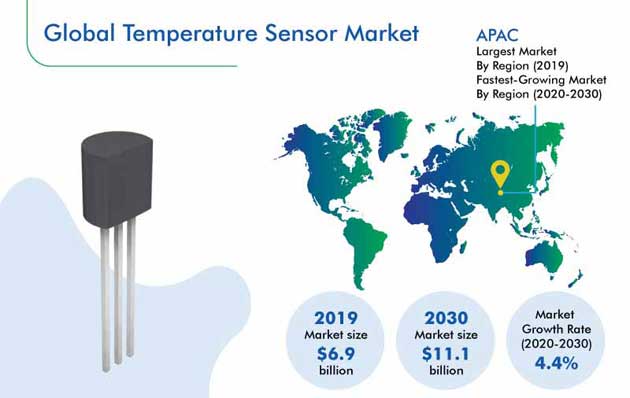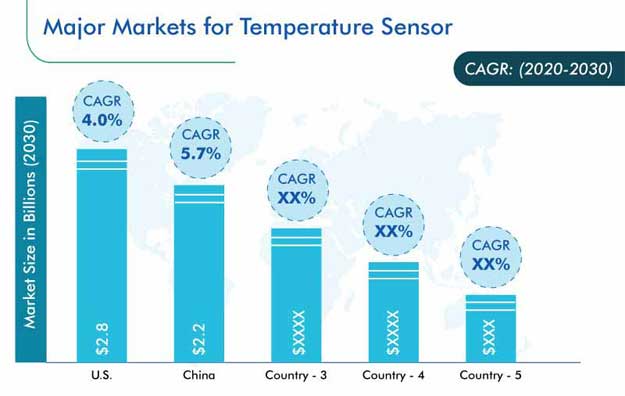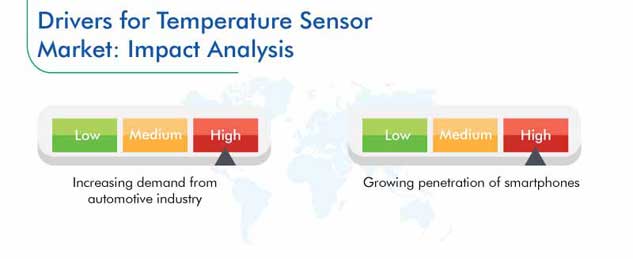Report Code: 11964 | Available Format: PDF | Pages: 301
Temperature Sensor Market Research Report: By Product Type (Temperature IC, Thermistor, RTD, Thermocouple), Contact Type (Contact, Non-Contact), Output (Analog, Digital), Vertical (Automotive and Aerospace, Petrochemical and Oil & Gas, Consumer Electronics, Food & Beverage, Pharmaceuticals, Utilities, Industrial) - Global Industry Analysis and Growth Forecast to 2030
- Report Code: 11964
- Available Format: PDF
- Pages: 301
- Report Description
- Table of Contents
- Market Segmentation
- Request Free Sample
Resistance Temperature Detector (RTD) the Largest Product Type in Temperature Sensor Market
From $6.9 billion in 2019, the global temperature sensor market is predicted to grow to $11.1 billion in 2030, witnessing a CAGR of 4.4% during the forecast period (2020–2030). The market is advancing owing to the increasing smartphone sales and rising demand for such devices from the automotive industry.

Segmentation Analysis of Temperature Sensor Market
Resistance temperature detectors (RTD) held the largest share in the temperature sensor market in 2019, under the product type segment. This is attributed to the fact that they are highly accurate, stable, and linear and they can be easily customized.
During the forecast period, the non-contact bifurcation, on the basis of contact type, is expected to experience the fastest growth in the market. This would be a result of the increasing preference of end users for these variants and the dropping prices of non-contact temperature sensors.
The digital bifurcation dominated the temperature sensor market during the historical period (2014–2019), based on output, as they offer the benefits of automated interrupts and programmable sampling, which is they witness higher demand from customers.
Till 2030, the food and beverages category, under segmentation by vertical, would display the highest CAGR. This is attributed to the wide usage of such instruments for monitoring the temperature of the food products and beverages during storage, processing, quality checks, and shipment. Further, these devices are also integrated in food and beverage processing machines, as their temperature also needs to be monitored. In Asia-Pacific (APAC), the food and beverages industry is displaying rapid growth, owing to the increasing trend of eating out, in addition to the rising consumption of processed foods.
APAC was the largest temperature sensor market in 2019, and the situation will be the same during the forecast period. This would be a result of the rapidly growing demand for processed foods in the region as well as the increasing urbanization rate and expanding automobile sector. China, which is the largest user of such electronics, in APAC, follows the U.S., as the second largest in the world.

Use of Body-Worn Sensors is Trending in Market
Among the numerous trends in the temperature sensor market is body-worn sensors. This is because with advancements in the healthcare sector, body-worn sensors are being used to monitor the condition of patients in real time. Additionally, with internet of things (IoT) finding its feet in the sector, the usage of body-worn temperature sensors is increasing. These instruments are integrated in custom-made devices for the healthcare industry or in smartwatches, in order to measure wearers’ temperature and pulse rate. With the rising popularity of wearable medical monitoring devices, smart watches, and fitness bands, the demand for body-worn temperature sensors is increasing.
Rising Demand for Temperature sensors in Automotive Industry
The key driver for the temperature sensor market is the rising requirement for these instruments in the automotive industry. Here, these devices are used to measure the temperature of the various gases, liquids, and systems within vehicles, to ensure proper functioning. Among the automobile components where these sensors are used are heating, ventilation, and air conditioning (HVAC) systems. With the growing sale of automobiles, particularly in APAC countries, including India, China, and South Korea, the demand for temperature sensors is surging.

Declining Personal Computing Device Sales is Hampering Market Growth
One of the factors hampering the growth of the temperature sensor market is the declining uptake of personal computers (PCs). A PC use up to four temperature sensor integrated circuits (IC) to maintain the temperature of numerous components, for their smooth functioning. The growing trend of working on smartphones and advent of the bring-your-own device (BYOD) policies in the corporate world are leading to less PC sales. Compared to 2017, PC sales declined by around 1.3% in 2018, when they stood at 259 million units. Additionally, the U.S.–China trade standoff has also led to a slump in PC demand, especially in APAC.
| Report Attribute | Details |
Historical Years |
2014-2019 |
Forecast Years |
2020-2030 |
Market Size by Segments |
Product Type, Contact Type, Output, Vertical |
Market Size of Geographies |
U.S., Canada, Germany, U.K., Italy, France, Spain, China, Japan, India, South Korea, Brazil, Mexico, Argentina, South Africa, Saudi Arabia, Turkey |
Explore more about this report - Request free sample
Product Launches are Most Important Strategic Measures among Market Players
In the recent years, numerous temperature sensor market players have looked at product launches as an effective strategic move to augment their revenue and get an edge over other companies offering these instruments.
For instance, in November 2019, the STTS22H temperature sensor was launched by STMicroelectronics N.V., for heat flow monitoring in asset trackers, shipping container loggers, HVAC systems, air humidifiers, refrigerators, building automation systems, and smart consumer devices; the device is accurate up to 25 degree Celsius.
Similarly, in September 2019, RS Components, which offers maintenance and electronic products, expanded its RS Pro range product range via the addition of non-contact infrared thermometers. These instruments can accurately sense temperature between 0 and 1,000 degree Celsius, and they are resistant to dust and water.
The major players in the global temperature sensor market are Honeywell International Inc., Infineon Technologies AG, ABB Ltd., TE Connectivity Ltd., Texas Instruments Incorporated, NXP Semiconductors N.V., Panasonic Corporation, STMicroelectronics N.V., Robert Bosch GmbH, Amphenol Corporation, On Semiconductor Corporation, and Analog Devices Inc.
Market Size Breakdown by Segment
The temperature sensor market report offers comprehensive market segmentation analysis along with market estimation for the period 2014–2030.
Based on Product Type
- Temperature IC
- Thermistor
- Resistance Temperature Detector (RTD)
- Thermocouple
Based on Contact Type
- Contact
- Non-Contact
Based on Output
- Analog
- Digital
Based on Vertical
- Automotive and Aerospace
- Petrochemical and Oil & Gas
- Consumer Electronics
- Food & Beverage
- Pharmaceuticals
- Utilities
- Industrial
Geographical Analysis
- North America
- U.S.
- Canada
- Europe
- Germany
- U.K.
- Italy
- France
- Spain
- Asia-Pacific (APAC)
- China
- Japan
- India
- South Korea
- Latin America (LATAM)
- Brazil
- Mexico
- Argentina
- Middle East and Africa (MEA)
- South Africa
- Saudi Arabia
- Turkey
In 2030, the temperature sensor market will be an $11.1 billion investment opportunity.
Non-contact variants are preferred by the end users in the temperature sensor industry.
Body-worn sensors are the current temperature sensor market trend because they are being used for real-time patient monitoring.
Product launch has been the most-effective strategic development in the temperature sensor industry.
The majority of the revenue for temperature sensor market players is coming from APAC.
Want a report tailored exactly to your business strategy?
Request CustomizationWant an insight-rich discussion with the report author?
Speak to AnalystOur dedication to providing the most-accurate market information has earned us verification by Dun & Bradstreet (D&B). We strive for quality checking of the highest level to enable data-driven decision making for you
Our insights into the minutest levels of the markets, including the latest trends and competitive landscape, give you all the answers you need to take your business to new heights
With 24/7 research support, we ensure that the wheels of your business never stop turning. Don’t let time stand in your way. Get all your queries answered with a simple phone call or email, as and when required
We take a cautious approach to protecting your personal and confidential information. Trust is the strongest bond that connects us and our clients, and trust we build by complying with all international and domestic data protection and privacy laws